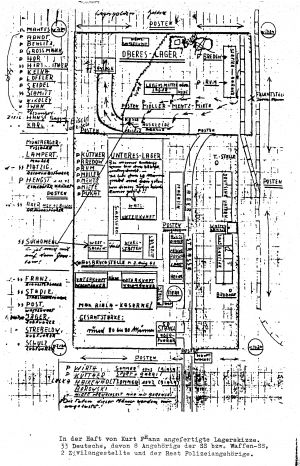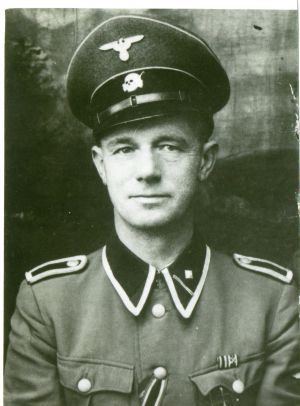SS GARRISON – SS-SONDERKOMMANDO TREBLINKA
List of Treblinka personnel drawn up by Kurt Franz awaiting trial
ARNDT, Kurt
Born in either 1912 or 1914 in Konigsberg. He belonged to a police detachment and he served at the Hadamar T4 Institute. According to Kurt Franz, his main duties at Treblinka were in Camp II, the Totenlager. Possibly served in Trieste. Nothing more is known.
BAER, Rudolf
Born on 28 March 1906 in Leipzig. He was employed as a carpenter in Halle, then he served in T4 as a cook at the Bernburg Institute. He then went to Belzec death camp. At Treblinka he was employed as a book-keeper in the camps' office. Willi Matzig replaced him when Franz Stangl became commandant. At the end of the war in May 1945, he was interned in a Prisoner of War camp at Kirchbach, Kärnten, Austria. He escaped from there and was never traced.
BIELA, Max
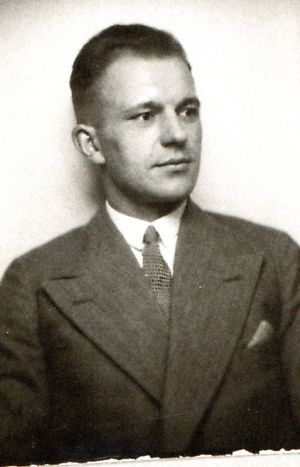
Born on 5 August 1905 in Leschen, Calau district. He was a farm worker in civilian life, he joined the SS and served in Sachsenhausen concentration camp from 27 January 1940 with the rank of SS Rottenfuhrer. He was transferred to T4 to serve as a guard at the Brandenburg and Bernburg Institutes. He was then transferred in the summer of 1942 to Treblinka death camp in Poland, as deputy to Commandant Dr Irmfried Eberl. He was fatally wounded in the camp on 11 September 1942, when he was attacked by the Jewish prisoner Meier Berliner, who stabbed him with a knife. Max Biela died of his wounds in the Reserve Military Hospital in Ostrow Mazowiecki. The Ukrainian barracks in Treblinka, were named the 'Max Biela Kaserne' in his honour.
BOELITZ, Willi
Born during 1909, in Berlin -Lichterfelde. Belonged to a police detachment, and after his recruitment to T4, he served in the laundry rooms at the Institutes in Grafeneck and Hadamar. He was posted to Treblinka in August 1942, where he served mainly in Camp II, the Totenlager. Together with Adolf Gentz he was also part of the Komando squad that received transports on the ramp; he also was one of guards who checked the wagons to ensure that no one remained inside. Treblinka survivor Richard Glazar described Boelitz:
Boelitz is quite another type, made of more solid stuff. He is a strong, lean, young man. It's not that his hair is cut short, shaved high in the back - in the Prussian military style - but gave the impression that the sun had bleached the eyebrows, and lashes blond, on his oval, rosy, pink face.
He served in Italy, when Aktion Reinhardt ended, but his fate is unknown.
BOOTZ, Helmuth
Born on 25 June 1907 in Stettin on the Baltic coast. After attending elementary school he was employed as a security guard at AEG - General Electrical Company. Bootz was a member of the Nazi Party and SS since 1933. He was recruited to T4 in the autumn of 1939. He was first employed at Grafeneck Institute as a guard and then in the Post Office at Bernburg from late October until the spring of 1942. Early in 1942, he was ordered to Treblinka, but he was released from his duties by Christian Wirth, due to chronic ill-health, in the spring of 1943. No further details known.
BOROWSKI, Werner
Born on 23 October 1913 in Sprottau in the Prussian province of Lower Silesia. He served at the Bernburg Institute as Head of the Economics Office. He was posted to the Belzec death camp in early 1942 and then to the Treblinka death camp. Because he fell victim to the typhus epidemic in the camp, after recovering, he was sent back to Bernburg. He joined the Luftwaffe and was reported 'missing in action,' presumed killed.
BREDOW, Paul
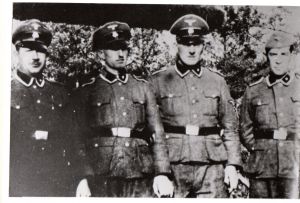
Paul Bredow - first left - in Treblinka
Born on 31 October 1903 in Guttland, Danzig District. A male nurse who served at the Grafeneck and Hartheim institutions. He was posted to the Sobibor death camp with Stangl and others. Bredow was in charge of the Lazarett at Sobibor, where he displayed untold cruelty in shooting Jewish prisoners. He served at Sobibor until the spring of 1943, when he was posted to Treblinka death camp, where he was in charge of "Sorting Barracks A," the clothing barracks. After the closure of Treblinka, he went to Trieste in Italy, and after the war he worked together with another former Sobibor staff member, Karl Frenzel in Giessen, as a carpenter until November 1945. In December 1945 he was killed in an accident in Gottingen.
BREE, Max
Born during 1914, in Lubben / Spreewald and he arrived at Sobibor from the Treblinka death camp around June 1943. Due to his relatively late arrival, very little is known about him, other than that he supervised the Ukrainian guards at well as the Jewish workers in the sorting barracks. He was killed during the prisoner revolt on 14 October 1943.
BRUCKNER, Bruno
Born during 1902 in Linz, Austria. A member of the Nazi Party and SS. After joining T4 he worked in the photographic department. He served in Treblinka during August until September 1942. He served in the Wehrmacht from February 1943, and settled in Austria after the war ended.
EISOLD, Johannes
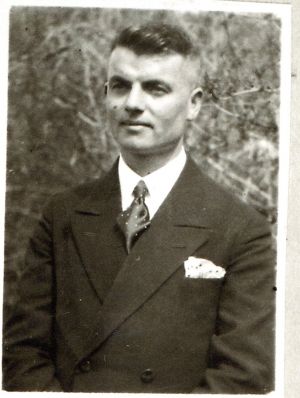
Born on 13 November 1907, in Konigstein. He served at the T4 Institute in Pirna / Sonnenstein. He later worked for the Wollenweber construction firm in Berlin, which hired out one of its excavators to Treblinka. Eisold was employed as an excavator driver in the Totenlager. After the liquidation of Treblinka he was posted to Trieste in Italy. No further details known.
FELFE, Hermann
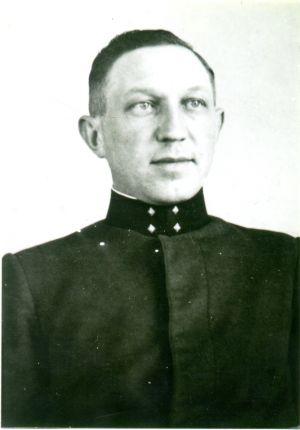
Born on 4 January 1902, in Jankwitz bei Bautzen.. He was a member of the Nazi Party, a bricklayer by profession. He was recruited by T4 and was employed as a male nurse at the Pirna/ Sonnenstein and Grafeneck Institues. Felfe was the builder of the first water tower in Camp I in Treblinka. According to both Mentz and Matthes, he was a guard, but he was only there at the initial stages of the camp's existence, although other sources claim he was there from September 1942 until August 1943. He was arrested in 1945 by the Russian NKVD. He was sentenced to death in the Dresdner Artzprozess on 7 July 1947. Felfe committed suicide in the Remand Prison on 15 October 1947.
FLORIAN, Alfred
According to the testimony of his colleagues Matthes and Rum, Florian was only at Treblinka for a short while, during the camp's early stages, possibly from August - November 1942. He was described as being about 40 years of age, hefty build, heavy faced and blond.
FLOSS, Erich Herbert
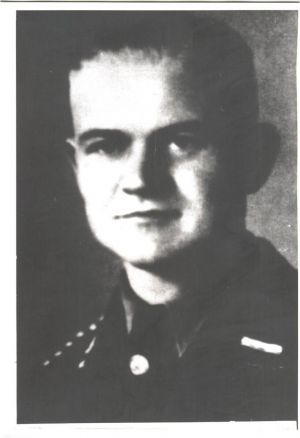
Born on 25 August 1912 in Reinholdsheim. He attended extended elementary school. After school he was trained in textile dyeing, but he could not secure a position in this line of work and consequently worked in several other jobs.
From 1 April 1935 he served in the 2 Totenkopfsturmban Elbe and saw service in the Buchenwald concentration camp and he also served at the T4 institution at Bernburg.
Erich Herbert Floss was to make a name for himself as the Aktion Reinhardt cremation expert which he put to good effect at Belzec, Sobibor and Treblinka death camps, during 1943. Floss was nicknamed by the Jews at Treblinka, as Tadellos (perfect); that was his favourite expression. Floss served mainly at Sobibor death camp He was one of the SS men who took the victims last possessions before they entered the 'Tube,' leading from Lager II to the gas chambers. One week after the revolt Floss escorted a group of Ukrainian guards to the Trawniki training camp when he was killed by one of them in Zawadowka, near Chelm.
FORKER, Alfred
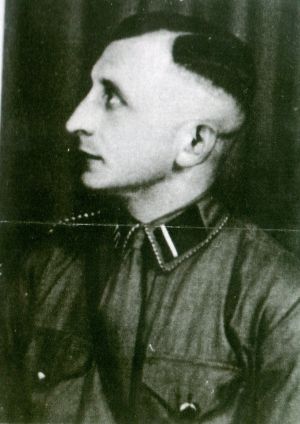
Born on 31 July 1904, in Sachsen.. He served as a male nurse at the T4 insttution at Pirna /Sonnenstein. Forker served in Treblinka as a guard in the sorting yard, and in the Totenlager. Described in the testimony of his colleague Otto Horn, as being small, with a tapering peaky face and dark blond hair. He also served at Sobibor death camp, and when Sobibor was liquidated he was posted to Italy. No further details are known.
FUCHS, Erich
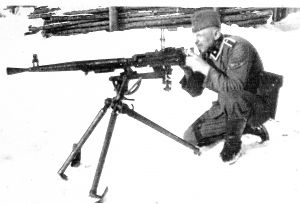
Fuchs photographed in the Belzec Kommandantur (Johann Niemann Album)
Born on 9 April 1902 in Berlin. After his education in an elementary school he trained to become a skilled motor mechanic and automative foreman. Before the Second World War he was a driver in Berlin and he joined the Nazi Party in the early 1930's and became a member of the SA and later the SS
He was drafted to T4 he worked as Dr Eberl's driver in the T4 institutions at Brandenburg and Bernburg, and was, as he expressed himself, 'an interested spectator' at the gassing of 50 mental patients.
In the winter of 1941 Fuchs was selected at Bernburg by Christian Wirth and posted to Belzec death camp. At Belzec he installed the" showers" the disguised gassing facilties and worked as a truck driver, in the motor pool transporting material to the death camp site. In April 1942 he collected a Russian water-
Erich Fuchs was then posted to Treblinka to assist with the installation of an engine in the gas chamber, which he testified; "Subsequently I went to Treblinka. In this extermination camp I installed a generator which supplied electric light for the barracks. The work in Treblinka took me about three to four busy months. During my stay there transports of Jews who were gassed were coming in daily."
In December 1942 Fuchs managed to arrange his release from T4 and from early 1943 he worked for the German oil company Ostland – Ol-
Fuchs worked till 1962 at a number of jobs as an assistant worker, locksmith and truck inspector at the TUV in Koblenz, he was arrested and held in custody from 8 April 1963. The Schwurgericht am Landgericht Hagen sentenced him to four years imprisonment on 20 December 1966 for being an accessory to the murder of at least 79,000 people. He died in Koblenz on 25 July 1980.
GENTZ, Adolf
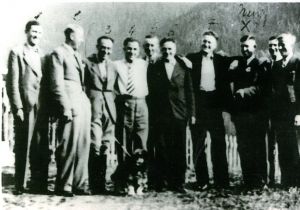
Gentz, first left at Attersee, Austria
Born during 1912, in Mark Brandenburg. Recruited by T4 and then Treblinka, from August 1942. Adolf Gentz served on the ramp at Treblinka. Richard Glazar recalled Adolf Gentz; If I imagine Gentz without the SS uniform, he could be a nice bright young man. I imagine him tossing his school bag into some corner and putting the field cap on his straight, bright red hair, buttoning his uniform jacket, grinning at the reflection in the mirror of the youthful freckled face with the strawberry blond eyebrows, and thinking, 'This is gonna be fun.' And when he got to Treblinka, and everyone around him eyed him with awe, then he told himself, 'Well, whadda ya know, this is fun.' After Treblinka was closed down Adolf Gentz was posted to the Sobibor death camp and assisted with the liquidation of that death camp. No further details known.
GROSSMANN, Willy

Born on 26 January 1901 in Lichtenberg, Saxony. He was a member of the Nazi Party and he was employed as a male nurse in the mental clinic in Hubertsberg, near Oschatz in Saxony until 1940. In the summer of 1940, he was posted to the police in Dresden, and then subsequently he served at the T4 Institute at Pirna / Sonnenstein, where he was employed as a guard. He also served at another T4 Institute at Hadamar.
In the winter of 1941, he went with part of the T4 squad to work for the Organisation Todt in Smolensk, Russia and then he returned to Pirna/ Sonnenstein for a short time. From there he was posted to the Trawniki SS Training camp in the Lublin district of Poland, and from there he was posted to the Treblinka death camp, where he stayed until the camp was liquidated in late 1943. According to Kurt Franz his main duties were in the Totenlager and also on the ramp in Camp I, where transports were received. After Treblinka was dismantled he was sent to Berlin and in December 1943, he was posted to Trieste, Italy, where he fought against the partisans. He also served in Telmezo, Italy as a guard of an ammunition storage facility. Grossmann was never brought to trial because of ill-health.
HACKENHOLT, Lorenz Maria
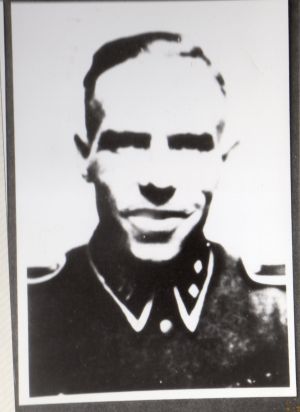
Lorenz Hackenholt in 1942
Born on 25 June 1914 in Gelsenkirchen. After attending the local elementary school until the age of 14 , he became an apprentice bricklayer and on passing the trade examinations worked on various building sites.
Lorenz Hackenholt joined the SS in 1934 and as part of the 2 Totenkopf Brandenburg Division was stationed at Oranienburg, north of Berlin, and he was transferred to the Sachsenhausen concentration camp in March 1938, where he was employed in the motor pool and as a driver for the camp command and personnel. In November 1939 he was summoned to Voss Strasse, along with Josef Oberhauser Siegfried Graetschus and Werner Dubois from the Sachsenhausen camp staff and was interviewed by Viktor Brack, the head of Hauptamt II of the Führer's Chancellery, and one of the men responsible for the Euthanasia programme, of killing mentally-
Lorenz Hackenholt drove the bus with SS NCO's in to the Grafeneck Castle institute in the Swabian Alps, south of Stuttgart. From the begining of 1940 when Grafeneck became operational until the summer of 1941 when the gassings were stopped on Hitler's orders, Lorenz Hackenholt served in all six T4 institutions, both as a bus driver and as a so-
After the termination of theT4 gassings, Hackenholt, together with a small group of SS NCO's from the Foundation, was transferred in the autumn of 1941 to serve the SS-
Lorenz Hackenholt rapidly became the gassing expert of Aktion Reinhardt, he was the one who started the motor which fed the three chambers with deadly carbon monoxide fumes, when the extermination camp became active in March 1942. A few months later he designed and supervised the construction of a new gas chamber building with six chambers, and which bore his name'Stiftung Hackenholt.' (Foundation Hackenholt). In August 1942 Lorenz Hackenholt was ordered to Treblinka by Christian Wirth, the Inspector of Aktion Reinhardt camps, in order to construct the larger gassing facility there. Erwin Lambert the T4 construction expert and Lorenz Hackenholt were then sent by Wirth to Sobibor death camp in order to build new gassing facilities there. After completing this task Hackenholt returned to Belzec death camp and he was subsequently involved in the exhumation and cremation of the gassed victims that had been buried in mass graves. In the spring of 1943 Lorenz Hackenholt returned to Treblinka on orders from Wirth to assist with the cremation operation. He was one of the excavator drivers.
Following the closure of Belzec in May 1943 Hackenholt was transferred to the Alter Flugplatz (Old Airfield) camp in Lublin, which was the main sorting, cleaning and storage depot for the vast amounts of belongings and valuables seized from the Jews murdered at Belzec, Sobibor and Treblinka. Valuable furs were disinfected with Zyklon B in four specially constructed chambers. After SS-
Whilst some of his former colleagues said in interrogations after the war had ended that Hackenholt had been kiiled in action, it would appear that he almost certainly survived the war and was living in the Allgau area around Memmingen – Kempten in the German – Austria border region. Was possibly spotted by his brother driving a delivery van. Lorenz Hackenholt has never been brought to trial and no further information is known
HENGST, August
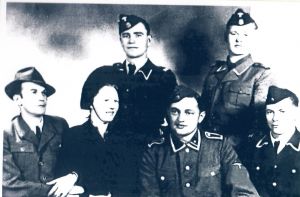
August Hengst, first left with other members from Treblinka
Born on 25 April 1905, in Bonn. His profession was a cook. Hengst was recruited by T4 on 4 January 1940 and he was posted to the Brandenburg Institute, where he helped install the kitchen. He was then posted to another T4 Institution at Bernburg, where he served as a cook from Novembe1940 until early 1942. During the spring of 1942, he was posted to Treblinka, along with Erwin Lambert, whilst the death camp was being constructed. He served as a cook for a short time and then a relief cook. After Treblinka was dismantled, he was posted to Italy- first to Udine, then Castel Nuovo and after a period of ill-health he was sent to San Sabba, Trieste, where he served as a cook, until the capitulation on 10 May 1945. After the war ended he worked in Stadthagen, near Hannover. He opened a bakery during 1949, in a nearby village, but in 1954, he closed the bakery because of ill-health. Another ex-colleague from T4 arranged for Hengst to work as a courier at the Deutsche Werft shipyard in Hamburg. No further details known.
HILLER, Richard
Born during 1899 in Braunsdorf bei Freiberg in Sachsen. After service in T4 he was posted to Treblinka where he worked in the Administration Office, from September 1942 until October 1943. After Treblinka was closed down he served in Fiume, Italy. He died in 1962.
HIRTREITER, Josef ' Sepp'

Sepp Hirtreiter far right in Treblinka
Born on 1 February 1909 in Bruchsal, which is 20 kilometres north east of Karlsruhe. After attending extended elementary school. He trained as a locksmith but failed the final examination. Later he worked as an unskilled construction worker and bricklayer. On I August 1932 he became a member of the NSDAP and SA.
In October 1940 he was ordered to the Hadamar institute where he worked in the kitchen and the office. In the summer of 1942 he was drafted into the Wehrmacht for a brief time before returning to Hadamar and then onto Berlin where Christian Wirth transferred him to Lublin and then onto Treblinka death camp.
Josef Hirtreiter was stationed at Treblinka from 20 August 1942 until October 1943 when he was transferred to Sobibor death camp to assist with the dismantling of that camp. At Treblinka he became much feared by the Jewish prisoners, and he was known by the nickname 'Sepp'.
In October 1943 he was ordered to Italy where he joined an anti-
Among the crimes he was found guilty of were killing many young children, aged one or two, when during the unloading of transports, by seizing the infants by their feet and smashing their heads against the boxcars. Because of ill-
HORN, Otto
Born on 14 December 1903, in Obergrauschwitz, near Leipzig. He attended elementary school until 14 -years of age, after which for four years, he worked on a farm. At 18-years of age he became a miner in Boerte. Otto Horn was then employed in a psychological clinic at Arnsdorf, serving two years apprenticeship as a nurse, before passing his final examinations. Then he was employed for two years at the psychological clinic in Leipzig/ Dosen, before returning to Arnsdorf.
In 1939, he was drafted into the German Army attached to a medical battalion serving in Dresden and then in Poland, also as a medic. In November 1939, he was stationed at Geldern and then to France. In August 1941, he was released from the German Army and posted to the T4 Institute at Pirna/ Sonnenstein, where he was employed as a male nurse.
In September 1942, he was posted to the Trawniki SS Training camp, and after two weeks training was posted in October 1942, to the Treblinka death camp. In the camp he served in the Totenlager, supervising the burial of Jews murdered in the gas chambers. Later on he supervised at the 'roasts' where the victims were burned. Otto Horn achieved the reputation of being a decent man who never hurt anyone, although Treblinka survivor Abraham Goldfarb testified that he once shot a prisoner.
Horn left Treblinka a month after the uprising in September 1943, and went on extended leave in Arnsdorf with a simulated illness. He was then posted in January1944, to Trieste, Italy, but he refused to work there and he was sent back to the Heil -und Pflegeanstalt in Arnsdorf. After 14-days in December 1944, he was ordered to the Landeschutzenbatalion in Plauen, possibly as a punitive measure. At the end of the war he was in Czechoslovakia, where the Russians captured him and incarcerated him in a Prisoner of War camp. Otto Horn was brought to trial in Dusseldorf during 1964/65, but he was acquitted and released.
KAINA, Erwin
Born on 24 March 1910, in Berlin. Together with his colleague Heinrich Unverhau, who later served in Belzec and Sobibor, was ordered to T4 during 1940, where they both served in Grafeneck Instutute killing the mentally ill. He was also employed in another T4 Institute at Hadamar. Both Kaina and Unverhau were male nurses by profession and they both disagreed with what was taking place in the euthanasia institutions. Kaina requested many times for a transfer. He was arrested and sent to a concentration camp . According to one account he was sent to Sachsenhausen concentration camp by Christian Wirth for talking about their work in a Hadamar bar.
Released from this incarceration he was posted to the Treblinka death camp and during the chaotic re-organisation Kaina was assigned by Christian Wirth to form a work-brigade and supervise the grisly work in the Totenlager. Kaina was aware if he protested again, he would be sent to a concentration camp. Because of this Kaina shot himself during the autumn of 1942, in Treblinka, out of desperation and fear. After his failed suicide attempt he died in the Reserve Military Hospital in Ostrow Mazowiecki on 31 October 1942.
KLAHN , Johannes
Born on 26 September 1908, possibly in Dresden. He was employed at the T4 Institute at Pirna/ Sonnenstein as a male nurse. He was a member of the Nazi Party. According to Kurt Franz he was assigned to duties in Camp I. No further details known.
KUTTNER, Fritz
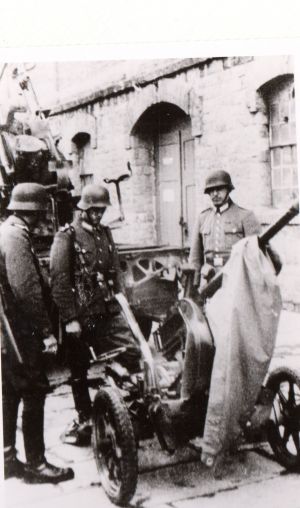
Kuttner far right in San Sabba Trieste
Born on 15 July 1907. He was a Polizeimeister from near Chemnitz. Described in a police report dated April 1945, intercepted by British Intelligence Service staff; as being about 38 years old, 1.74 metres tall, fair hair parted on the left; somewhat protruding forehead; oval sharp-featured face; blue eyes.
Fritz Kuttner was in charge of Camp I in Treblinka and he was one of the most hated and feared of all the SS-garrison. He would follow the inmates around, stop them and search them for money, pictures or any family mementos that the prisoners had tried to conceal. If Kuttner found anything he would beat them without mercy and send them to the Lazarett for immediate execution. He also was one of the most brutal SS men in carrying out floggings of the prisoners. In his capacity as the chief of Camp I, he wanted to know exactly what was going on, and he therefore established a network of Jewish prisoner informers, such as Chaskiel and Kuba. In the camp he was given the nickname 'Kiwe' by the Jewish prisoners.
Kuttner was wounded in the Treblinka uprising on 2 August 1943, and after the revolt he was posted to San Sabba , Trieste. In July or August 1944, an Aussenkommando from the HSSPF Adriatic coast arrived in Milan to pursue the 'Jewish Question.' The squad consisted of Stangl, Kuttner, Post and Gomerski, all former members of Aktion Reinhardt. This Aussenkommando carried out arrests and were based in a office at La Corso del Littorio. They returned to Trieste in mid-March 1945. Kuttner was arrested after the war, but he died on 31 December 1950, without ever being brought to justice.
LAMBERT, Erwin
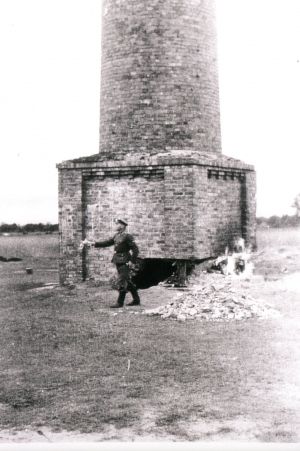
Erwin Lambert at Malkinia - Destruction of Factory Tower
Born on 7 December 1909 in Schildow, Kreis Niederbarnim, near Berlin. He was a member of the NSDAP since 1933 and a mason by profession. In January 1940 he was recruited to T4 and his first assingment was the renovation of the T4 villa in Tiergartenstrasse 4. He installed the gas chambers at the institutes of Hartheim, Pirna/ Sonnenstein, Bernburg and Hadamar.
In the Spring of 1942 he was ordered to Lublin and then onto the Treblinka death camp, he arrived there with August Hengst, and under the command of Richard Thomalla was responsible for construction work on the first gas chambers and other buildings. In August 1942 he was responsible for the demolition of a glass factory chimney in Malkinia, which was photographed by Kurt Franz, and the bricks were used in the construcion of the larger gas chambers building in Treblinka. He was called the 'Flying Architect of T4,' because he also undertook construction works at T4 establishments, such as the villa used for recreation by the death camp personnel at Attersee.
Erwin Lambert also was involved along with Lorenz Hakenholt in the construction of larger gassing facilities at the Sobibor death camp, as well as as general construction work in the Jewish Labour camps at Dorohucza and Poniatowa. After Aktion Reinhardt ended he was posted to Trieste, Italy. Afer the war Lambert was arrested on 28 March 1962 and was tried at the Treblinka Trial which was held in Dusseldorf during 1964/1965. He was found guilty and sentenced to four years in prison.
LINDENMULLER, Alfons

Born during 1914, in Trossingen. Served at Treblinka from September 1942, until February 1943, where he was in charge of the Goldjuden. According to prisoner Richard Glazar Lindenmuller visited him and told him he had volunteered for service in the front line following his Christmas leave period in December 1942. Lindenmuller died on 27 July 1946 in a Prisoner of War camp in Ksawerea- Koszelew, a suburb of the city of Bedzin , in Upper Silesia.
LOFFLER, Alfred
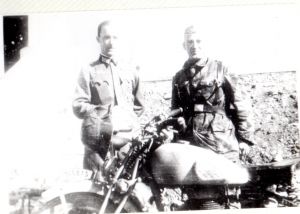
Loffler on the left with Seidel in Italy
Born on 15 September 1904, in Basle, Switzerland and he arrived in Treblinka on 20 August 1942, after service in T4. He was employed in Camp II. Jewish prisoner Jankiel Wiernik recalled that just before the revolt that his superior Loffler was transferred to the Lublin concentration camp (aka Majdanek). From Lublin, Loffler was posted to Italy, where he was killed in action on 30 April 1944. He is buried in the German Military Cemetery at Costermano, near Verona, Italy.
LUDWIG, Karl Emil
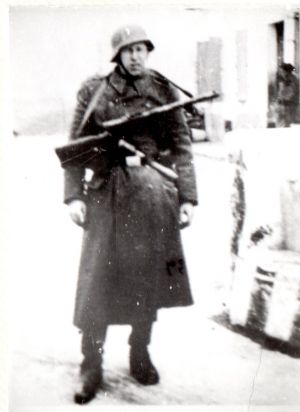
Karl Ludwig in Italy
Born on 30 November 1904 in Storkow. A driver by profession he was the chauffeur of Reichsleiter Martin Bormann and for T4 headquarters. He was posted to the Sobibor death camp from April 1942 until January 1943 where he served in Lager III, the extermination area. In January 1943 he was posted to Treblinka, where he also served in Lager II, the extermination area. Joe Siedlicki recalled in an interview with Gitta Sereny, that Karl Ludwig was; "He was a good, good man. The number of times he brought me things, the number of times he helped me, the number of people he probably saved, I can hardly tell you." After Treblinka death camp was dismantled he served in Italy, he survived the war.
MATTHES, Heinrich Arthur
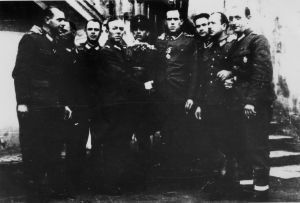
Matthes fourth from left congratulates Hackenholt on his award of the Iron Cross in Trieste
Born on 11 January 1902 in Wermsdorf, Kreis Leipzig. He attended extended elementary school and became a tailor. In 1924 he served an apprenticeship as a male nurse and educator and took his examinations at the mental home Pirna/ Sonnenstein near Dresden.
At the psychological clinic in Arnsdorf, also near Dresden he served as a male nurse and educator. In 1930 he worked as an educator and welfare worker to an institute in Braunsdorf, near Freiburg / Sachsen, returning in October 1933 to Arnsdorf. Heinrich Matthes became an SA member in 1934. In 1939 he was drafted into the Wehrmacht, where he served as a soldier in Poland and France until September 1941. His last rank in the Wehrmacht was Obergefreiter.
Released from the Wehrmacht, Matthes was ordered to the Kdf (Kanzlei des Führer) where he was posted to the T4 organisation. He spent a short time in the photograph section. In the winter of 1941/42 he served as a member of the Organisation Todt, in Russia, where he served as a male nurse in the Minsk and Smolensk areas. In February / March 1942 he returned from Russia and served in the same photograhic section at T4.
In August 1942 he was ordered to Lublin, where he was drafted into the SS and given the rank of SS-
From Treblinka he was posted to the Sobibor death camp in September 1943 where he stayed until the camp was dismantled and afterwards was stationed in Berlin. In early 1944 he was posted from Berlin to Trieste in Italy, now with the rank of Polizei –Oberwachtmeister. In Trieste he fought against partisans, took part in millitary construction work and served as a guard until the end of the war.
n 1945 he was captured by US forces, but was released the same year. Returning to Germany in Nuremberg he worked as an ambulance man, helped removing rubble and was employed as a male nurse again, at the mental homes in Ansbach, Andernach and finally Bayreuth. In the Treblinka Trial held during 1964/65 in Dusseldorf he was sentenced to life imprisonment.
MATZIG, Willy

Born on 6 August 1910 in Berg, Oberlausitz. After leaving school his first profession was as a glasscutter. In October 1933 he became a member of the Allgemeine SS with the rank of SS-
In Berlin recruited as a member of T4 from February / March 1940 and he served as a guard at the Brandenburg institute for one year, and in 1941 was posted to Bernburg, where he again served as a guard and an admistration assistant until August 1942.
In August 1942 he was posted to Treblinka death camp where he performed book-
Following the dismantling of Treblinka he was in Sobibor for a short while, and then in Trieste till the end of the war. No further details known.
MEIDKUR, Kurt
An SS-Unterscharfuhrer who served in Treblinka. No further details known.
MENTZ, Willi

Mentz second from left in Treblinka
Born on 30 April 1904 in Schonhagen, Kreis Bromberg. After school he found employment as an unskilled worker in a sawmill and then passed his master milkman's examination. In 1940 he took care of cows and pigs at the Grafeneck institute and from 1941 to early summer 1942 worked in the gardens at Hadamar.
From June – July 1942 he was posted to Treblinka death camp where he was assigned at first to Camp II and then to Camp I as chief of the Landwirtschaftskommando (Agricultural Commando). Willi Mentz was also assigned by Wirth to supervise the Lazarett, where he became one of the most brutal killers, much feared by the Jewish prisoners.
After Treblinka was dismantled he served for a short time at Sobibor death camp and from there he was posted to Italy, fighting partisans and persecuting Jews. After the war ended he worked again as a master milkman. In the Treblinka trial held in Dusseldorf during 1964/65 he was sentenced to life imprisonment.
MICHEL, Hermann
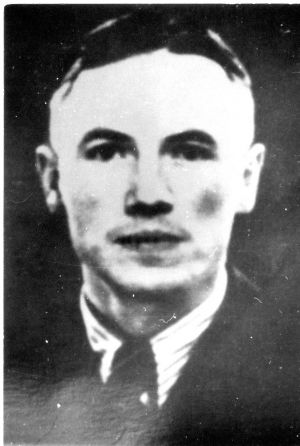
Born during 1906, in Heegermuhle, Hermann Michel was a T4 man who served at Grafeneck and Hartheim institutes. He was posted to the Sobibor death camp from April 1942, and he was a friend of Franz Stangl, the first commandant of Sobibor. He used to welcome the new arrivals in Lager II with a short speech in order to win their confidence by pretending that they had arrived at a labour camp and must be disinfected and bathed for reasons of hygiene. He was later transferred to Treblinka in November 1942. After the war he fled to Egypt. No further details known.
MIETE, August Wilhelm

Born on 1 November 1908, in Westerkappeln, Kreis Tecklenburg. Until May 1940, he worked at his parents mill and farm. He showed an interest in becoming a settler in the East and asked about it at his local agricultural chamber. He was drafted to the agricultural chamber in May 1940, and became the caretaker of a large property, including a mental clinic. After eight days he was ordered to the T4 Institution at Grafeneck, where he remained until the autumn of 1940. From Grafeneck he was posted to another T4 facility at Hadamar, which was under construction. He remained at Hadamar until the summer of 1942, when he was posted to Lublin and then onto Treblinka, in June 1942, while the camp was still being constructed.
He became one of the most cruel men in Treblinka, the Jewish prisoners nicknamed him 'Malakh Ha-Moves' - Yiddish for the 'Angel of Death.' He was also known as ' Krimme Kepel' - Crooked Head. He was assigned to Camp I, where he was employed on the ramp, and at the 'Undressing Square.' He was then placed in charge of the Lazarett - it was he who carried out the most killings. He would walk around, check the prisoners, and those who seemed to him to be sick, or too weak to work, would be taken straight to the Lazarett and he would execute the prisoners without mercy. It was Miete who killed the Jewish prisoner Meier Berliner, after he had stabbed and fatally wounded Max Biela, on 11 September 1942.
After Treblinka was dismantled he was sent to Trieste, Italy, and after a short time there was moved to Udine. In the autumn of 1944, he was transferred from Udine to Upper Italy and was attached to a demolition unit. Returning to Germany he lived undisturbed until the 27 May 1960, when he was arrested and held in Dusseldorf- Derendorf prison. At the Treblinka trial held during 1964/65 in Dusseldorf he was sentenced to life in prison. Miete died in prison .
MOELLER, Max

Moeller third from left in Treblinka
From Hamburg, by profession a male nurse. He was assigned to Camp I, according to Kurt Franz. He served as an ordinance officer. Max Moller was given the nickname of ' Amerikaner' because of his build, according to Kalman Teigman, in private correspondence with Chris Webb
MULLER, Adolf
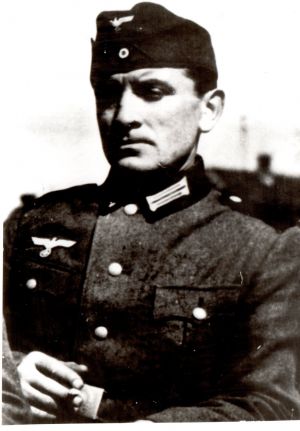
Adolf Mueller arrived in Sobibor in the summer of 1943. He served mosty in Lager II, in the sorting barracks and in charge of the Waldkommando. During the revolt he kept a group of prisoners of the Waldkommando under armed guard.He died on 10 March 1949 in Berlin. He also served at Treblinka in the camp administration, and some prisoners recall a surname of Miller.
MUNZBERGER, Gustav
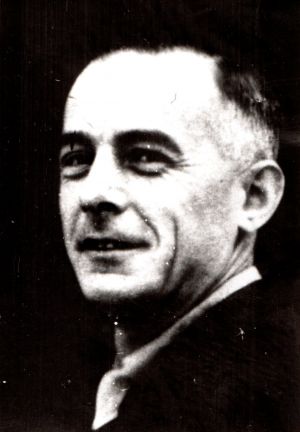
Born in Wieskirchlitz, in the Sudetenland. He attended elementary school, then for two years at a public school in Turn. After school he worked until 1923, as a carpenter, in his father's firm, and afterwards for a few months in the Wieskirchlitz Paper Factory. After his medical examination for military service, he served in a railway regiment in Pardubice for eighteen months. From the autumn of 1925, he returned to work in the paper factory and then from 1931 until August 1940 in his father's farm, which he now ran.
In August 1940, he was ordered to the T4 Institute at Pirna / Sonnenstein, where he was employed as a carpenter and also as an assistant cook. Together with about fifteen others he was posted under the command of Ernst Schemmel to Lublin, possibly to the SS Training Camp at Trawniki. He was then posted to Treblinka in late September 1942, and he was employed in Camp II, the Totenlager, as assistant to Heinrich Matthes. He was responsible for chasing people into the gas chambers, and the 'Body Transport Squad.' During the Treblinka revolt he was at home on leave.
After Treblinka closed down in November 1943, he was sent to Trieste, Italy. After the war he lived undisturbed until he was arrested on 13 July 1963. At the Treblinka trial during 1964/65 he was sentenced to twelve years in prison. He was released from prison in July 1971, due to his good behaviour.
PLIKAT, Heinz
Born on 14 May 1907, in Insterburg in East Prussia, lived in Berlin. At Treblinka, he arrived in November 1942 until the spring of 1943, where he was assigned to Camp I according to Kurt Franz. One of fellow guards at Treblinka, Albert Rum testified that Plikat was known as a 'SA-rascal.' He was short in stature, blond, with little hair. After Treblinka he served in Trieste, Italy. No further details known.
POST, Philipp
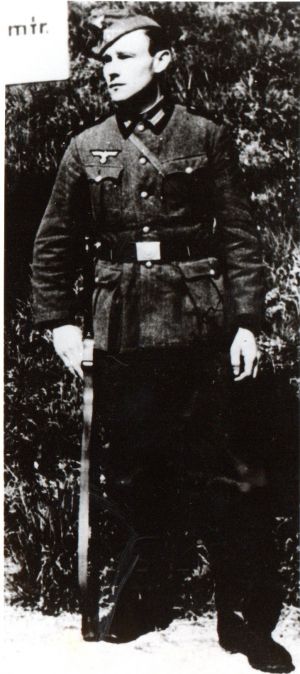
Philipp Post was born during 1911, in Bad Vilbel, Hessen. He held the rank of a Polizeioberwachtmeister and in a police report dated March 1945, intercepted by British Intelligence he was described as circa 32 years of age, from the Frankfurt am Main area, about 1.73 meters tall; well built with brown hair and a rather red face. Philipp Post arrived in Treblinka on 20 August 1942 and according to Kurt Franz, Post served in Camp I as a weapons guard and when Treblinka was closed he served in Italy fighting the partisans.
POTZINGER, Karl

Karl Potzinger front row third from left with other Treblinka staff
Born in1908, in Marktredwitz. Recruited into T4 he served at the Brandenburg and Bernburg institutions, where he incinerated the bodies. He was posted to Treblinka where he worked in the Totenlager, in charge of the burial pits, then the cremations. When Treblinka was closed he served briefly in the Sobibor death camp, before being posted to Italy. Karl Pötzinger was killed on 22 December 1944 in an air-
REUTER
Reuter was mentioned by Stanislaw Kon in his account of the revolt at the camp as having been told by Camp Elder Galewski that Reuter gone to Malkinia to bathe in the River Bug. No further details known.
RICHTER, Kurt
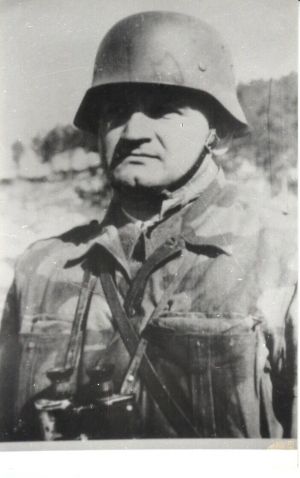
Kurt Richter in Italy
Born during 1914, in Karlsbad, Bohemia and by profession was a butcher. He was recruited into T4 and served at Pirna/ Sonnenstein and Hartheim institutions. Posted to the East, he first went to Treblinka death camp as a cook, and was transferred to Sobibor death camp in December 1942. At Sobibor he used to take the sick from the Ramp to the Lazarett, and he also supervised the work in the 'haircutters' barracks and took part in the execution of the workers in the Waldkommando.
After Sobibor he was posted to Italy, and he was killed in a fight with partisans on 13 August 1944 near Trieste. Erich Bauer testified that he transported Richter's body to the local cemetery.
RITTLER, Albert
Born during 1910, in Burgau. After service in T4, he was posted to Treblinka during May or June 1942, until November 1942. Died in April 1944
ROST, Paul

Born on 12 June 1904 in Deutschenbora near Meissen. After attending extended elementary school he trained to become a butcher. In 1925 he became a member of the police in Dresden and in 1937 became a member of the Nazi Party. On 21 May 1940 he was posted to the Pirna/ Sonnenstein institute , where he commanded the police squad and transportation command. He also served at Hartheim institute
Rost was posted to Sobibor death camp in April 1942, he was initialy the deputy commandant but was succeeded by Floss and Niemann respectively. He supervised the sorting of Jewish property in Lager II and also had to secretly spy on the other SS staff. He was transferred to Treblinka in May 1943; Rost was transferred to Trieste in December 1943 and he was promoted to police lieutenant on 9 November 1944 and awarded the Kreigsverdienstkreuz class II.
After the war had ended he was a Prisoner of War in a US ran camp but was released and returned to his family in Dresden. He was subsequently imprisoned by the Soviet Millitary Authority until the summer of 1946, then once again released. He lived and worked untroubled in Dresden until his death on 21 March 1984.
RUM, Franz Albert

Born on 8 June 1890 in Berlin. By profession he was a waiter in a night-
SCHARFE, Herbert
Born on 13 February 1913 in Konigstein, Sachsen. He served at the T4 institute at Pirna / Sonnenstein, employed in the economics office. Sent to the Treblinka death camp he was in charge of the camouflage commando. He also served at Sobibor death camp. No further details known. sc
SCHEMMEL, Ernst
Born on 11 September 1883, in Kirchhain, located between Dresden and Berlin. A career police officer, he was a member of the Kripo (Criminal Police). He was employed at the T4 Institute at Pirna / Sonnenstein and at another T4 Institute at Hartheim , Austria. He served at the Belzec death camp and then served at Treblinka from late September to early October 1942, where he acted as a deputy for commandant Franz Stangl. He died from a heart attack in Dresden on 10 December 1943.
SCHIFFNER, Karl

Schiffner third from left in Trieste
Born on 4 July 1901 in Weiskirchlitz, under the name of Kresadlo. He attended extended elementary school and later at the public school in Weiskirchlitz. He served a three year apprenticeship as a carpenter at a Trade school. He then served in the Czech army during the years 1921 -
Until 1942 he served at the T4 institute at Pirna / Sonnenstein and was then sent to Treblinka, where he was in charge of the camp joinery and construction team. During June / July 1943 he anda group of twelve Ukranians under his command went to Belzec to supervise the construction of a farmhouse on the former camp site, which was to be occupied by a Ukrainian family to keep a close watch on the site.
He also served at the Sobibor death camp and from there he was posted to Trieste, in a police unit, which fought partisans until the end of the war. Schiffner made his way to Karnten, Austria where he was captured by the British, and interned in a Prisoner of War camp at Usbach. He was released in October 1945, he made his way to Salzburg and disappeared. No further details known.
SCHMIDT, Fritz

Fritz Schmidt in Treblinka
Born on 29 November 1906, in Eibau, Saxony. He was employed in the T4 Institute at Pirna/ Sonnenstein in 1940, as a guard and driver and in 1941, he was transferred to the T4 institute at Bernburg. He was posted to Treblinka in the summer of 1942. In Treblinka he served in the Totenlager, where he supervised the gas chambers. He was also in charge of the garage and was chief of the metal workshop. He was transferred to Sobibor during September 1943, until the camp was liquidated. He was then posted to Trieste, Italy and was captured by the Americans at the end of the war, but was released and he returned to Germany. He was arrested in Saxony and put on trial. On 14 December 1949, he was sentenced to nine years in prison, but he escaped and went to West Germany, where he lived undisturbed until his death on 4 February 1982.
SCHUH, Richard
Born during 1910, in Frankfurt. According to Franz Suchomel, Richard Schuh, from Frankfurt am Main arrived in Treblinka with him, along with Matthes, Loffler, Post and Sydow on 20 August 1942. Richard Schuh's name appeared on a promotion list dated 20 March 1943, for Einsatz Reinhard bearing his current rank, which was SS-Rottenfuhrer to be promoted to SS-Unterscharfuhrer and his SS number was 98020. No further details known.
SCHULTZ, Erich
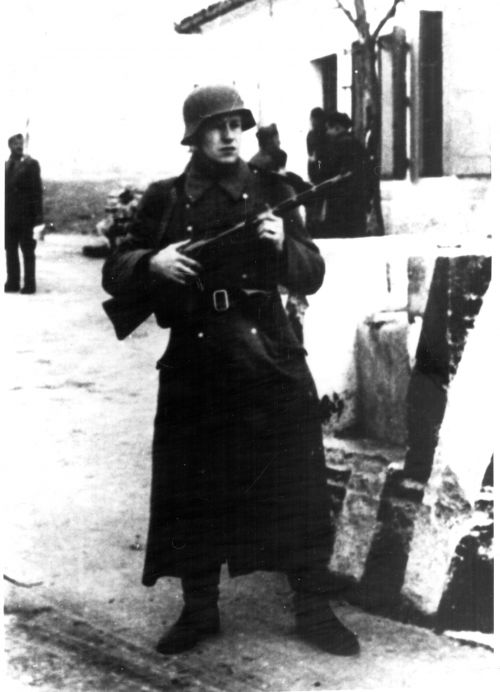
Erich Schultz in Italy
Born on 3 September 1902. Employed from 1940, at the T4 Institutes at Grafeneck, Hadamar and Pirna / Sonnenstein, as a 'burner' of corpses in the crematoria. Transferred to Treblinka where he was employed as a platoon leader. After Treblinka, he served in Einsatz R in northern Italy. No further details known.
SEIDEL, Kurt

Loffler and Kurt Seidel in Italy
Born during 1894, in Augustusburg, near Chemnitz. He was employed at the T4 Institute at Pirna/ Sonnenstein as a male nurse and in the administrative office. He was posted to the Treblinka camp in September 1942 until November 1943. The main road in the Lower Camp was named in his honour 'Kurt Seidel Strasse' - a one lane main street that road from the road entrance to the SS garage. When Treblinka was dismantled he was posted to Trieste, Italy, until the war ended. He died in a Soviet Prisoner of War camp.
SEIDLER, Ernst
Born during 1902, in Netzschkau. Following service in T4, he was posted to Treblinka in September 1942, where he served in the Totenlager. Was later posted to the Adriatic Coast, and then to the Ukraine, where he was killed in action during November 1944.
STADIE, Otto
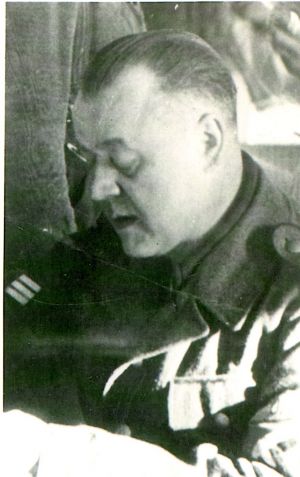
Born on 10 March 1897, in Berlin. Before the Second World War he was employed as a male nurse at a mental clinic Heil -und Pflegeanstalt Berlin. Afterwards he worked as an ambulance sergeant in an engineer infantry company. From mid-1941, he served at the T4 Institute at Bernburg, and during the winter 1941-42 he served with the Organisation Todt on the Eastern Front. He was transferred to Treblinka from July 1942, where he assisted the camp's administration. Stadie was one of two senior administrative assistants. He also served as the company commander of the Ukrainian guard unit in Treblinka. He was also part of the SS squad which received transports at the ramp. The Jewish prisoners nicknamed him 'Fesele' which is Yiddish for barrel - a sarcastic reference to his build.
Resulting from a disciplinary case Stadie was transferred to the Old Airfield (Alter Flugplatz) camp in Lublin, where he was placed in charge of a guard unit. He later served in San Sabba, Trieste, Italy and he survived the war. Arrested in Germany on 15 July 1963, he stood trial in Dusseldorf, where he was sentenced to seven years imprisonment. He was released from prison due to ill-health.
STEFL, Thomas
Born in Krummau in the Sudetenland, now Czech Republic and he arrived in Sobibor death camp in February 1943. He first served in the Treblinka death camp and arrived at Sobibor shortly before the prisoner revolt on 14 October 1943. Franz Suchomel was the only person who named this SS man and stated he was killed during the revolt.
STENGELIN, Erwin
Erwin Stengelin was born on 10 August 1911 in Tuttlingen. He seved a the T4 institute at Hadamar. He was posted to the East and served at the Treblinka death camp where he was assigned to Camp I. He was transferred to Sobibor death camp in September 1943 and he was killed during the prisoner revolt on 14 October 1943.
STREBELOW
According to Kurt Franz, he was assigned to Camp I in Treblinka as an SS-Zugfuhrer. No further details known.
SUCHOMEL, Franz

Born on 3 December 1907 in Krummau, Sudetenland, now the Czech Republic. By profession he was a tailor. He worked from 1940 until 1942 in the T4 in Berlin and at the Hadamar institute.
Ordered together with Hirtreiter, Post, Loeffler, Sydow, Matthes and two men from Frankfurt am Main, they arrived in the Treblinka death camp on 20 August 1942. Initially he was employed at the unloading ramp, then as a supervisor in the women's undressing barracks, leading the victims to the 'Tube.' Later he was in charge of the Goldjuden, and the tailor shop. When Adolf Eichmann and Odilo Globocnik visited Treblinka, Suchomel had to report to them about the work of the Goldjuden. In late October 1943 he was ordered to the Sobibor death camp. After the closure of Sobibor he was posted to Trieste, Italy.
At the end of the war he was captured by US forces and incarcerated in a Prisoner of War camp. In August 1945 he was released and he returned to Germany. Since 1949 he lived in Alotting, in Bavaria, which was where he was arrested on 11 July 1963. In the Treblinka Trial 1964/65 he was sentenced to six years in prison, but was released in 1969.
SYDOW, Hermann
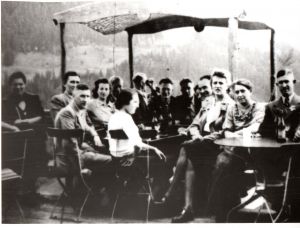
Hermann Sydow first left at Lake Attersee Austria
Born either in 1899 or 1900. According to Richard Glazar Sydow was a docker from Hamburg, and at Treblinka he was in charge of the camouflage commando. Glazar recalled that Sydow was a short little guy, but very tough, with an unbelievable appetite for alcohol. After Treblinka closed down, he was posted to Sobibor, and after that camp closed he was posted to Italy. No further details known.
WENGLER
At Treblinka during the initial phase of the camps existence, with the rank of SS-Unterscharfuhrer. Berated by Wirth in August 1942, on Wirth's first day at the death camp.
ZANKER, Hans
Born on 8 September 1905, in Sachsen. He served in the T4 institutes of Pirna / Sonnenstein as a cook. He served at the death camps in Poland including, Belzec, Sobibor and Treblinka. He also served in the Jewish labour camp in Poniatowa, and was posted to Trieste. No further details known.
REICHSBAHN PERSONNEL CONNECTED WITH TREBLINKA
BLECHSCHMIED
The German Reichsbahn employee, who drove a tender/ railway taxi from the Treblinka village station on the first day of operation at Treblinka, as recalled by Franciszek Zabecki, the Polish Railway Traffic Supervisor. Blechschmied helped supervise the shunting of the first transport of Jews from the Warsaw ghetto on 23 July 1942, from the village station along the side-track into the death camp.
BENNER
A superintendent who was responsible for the railway station at Malkinia, who took over the adminstrative control of Treblinka, in the summer of 1943. . He often visited the Treblinka death camp and personally witnessed the arrival of transports of Jews.
EMMERICH, Rudolf
A German Reichsbahn official, originally from Dresden. He oversaw the shunting of deportation trains from the Treblinka village station into the death camp.
KLINZMANN, Willi
A German Reichsbahn official from Wuppertal, who worked with Emmerich in shunting the trains from the Treblinka village station into the death camp. Franciszek Zabecki wrote that Klinzmann along with another SS man from the camp, kicked a pregnant Jewish woman to death at the Treblinka village station.
TEUFEL
He was an assistant to Blechsmied, as remembered by Franciszek Zabecki, who helped supervise the shunting of the first transport to arrive at Treblinka village station, before going into the death camp.
Sources
ARAD, Yitzhak, Belzec, Sobibor, Treblinka (Bloomington: Indiana University Press 1987)
BERGER, Sara, Experten der Vernichtung das T4-Reinhardt Netzwerk in das Lagern Belzec, Sobibor, Treblinka (Hamburger Instituit fur Sozialforschung Hamburg 2013)
BOHM, Dr Boris, Nationalsozialistische Euthanasiaverbrechen in Sachsen (Dresden Pirna Kuratorium Gedenkstatte Sonnenstein 1996)
BOHM, Dr Boris, Sonnenstein Heft 3 (Pirna Kuratorium Gedenkstatte Sonnenstein 2001)
BURBA, Manfred, Treblinka (Pachnicke, Gottingen 2000)
CHROSTOWSKI, Witold, Extermination Camp Treblinka, (Vallentine Mitchell London 2004)
CYMLICH, Israel & STRAWCZYNSKI, Oskar, Escaping Hell in Treblinka (Yad Vashem New York & Jerusalem 2007)
DONAT. A, The Death Camp Treblinka (Holocaust Library New York 1979)
GLAZAR, Richard, Trap with a Green Fence (Northwestern University Press Evanston 1992)
KLEE, Ernst, Das Kulturlexikon zum Dritten Reich (Fischer S. Verlag GmbH 207)
KLEE, Ernst Was sie Taten - Was sie Wurden (Fischer Taschenbuch Verlag 1986
RAJCHMANN , Chil, Treblinka (Maclehose Press London 2011)
SERENY, Gitta, Into That Darkness (Pimlico London 1974)
SMITH, Mark S, Treblinka Survivor (The History Press 2010)
WEBB Chris & CHOCHOLATY Michal, The Treblinka Death Camp (Ibidem-Verlag 2014)
WILLENBERG, Samuel, Surviving Treblinka (Basil Blackwell, Oxford 1989)
Kalman Teigman - Personal Correspondence
Bundesarchiv
Ghetto Fighters House, Israel
Fotos Aus Sobibor (Metropol Verlag, Berlin 2020)
Landgericht Dusseldorf
Wiener Library, London
Yad Vashem, Israel
www. HolocaustResearchProject.org
© Holocaust Historical Society March 4, 2025


